Any sewerage system is a potential hazard to sources of drinking water and environment. Therefore, there is a concept secured territory sewerage - snip determine the size of the territory and the standards for its designation. It is prohibited to build, plant trees and perform a number of other works in the protected area. Consider what rules for equipping security zones today are accepted in construction.
Surely, many have seen the installed signs, which indicate that a protected zone is located in this place. Such plates are placed, for example, in places where electrical cables are laid. In the area covered by the established plate, it is strictly forbidden to carry out unauthorized land work.
There are also security zones for water supply and sewerage. They are designed to address two issues:
- For the purpose of environmental protection.
- To protect pipelines from damage.
General concept of the sewer protection zone
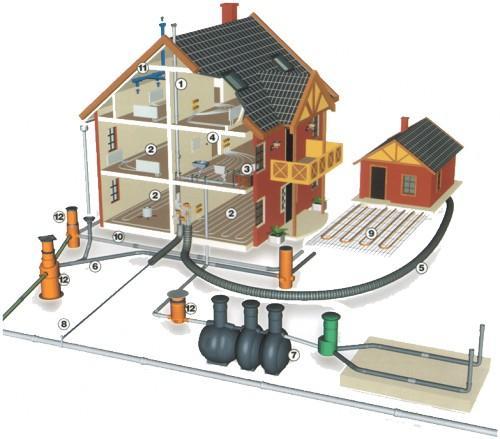
Sewerage protection zones are the territories that surround the buildings of sewer networks. Within the sewer zones, the following actions should be refrained from:
- Planting trees;
- Digging trenches and pits;
- Storing firewood or any other materials;
- Landfill device.
- Planning the construction of some buildings, piling or blasting.
- Carrying out work that raises or lowers the level of the soil, that is, the production of sections of the soil or its backfilling.
- The device of the road surface reinforced concrete slabs, even if this road is temporary.
- The performance of any actions, as a result of which the passage to the sewer networks will be blocked.
As a rule, the boundaries of protected zones are prescribed in a decree issued by the Ministry of the Environment. Exact information about the size of the protection zones can be obtained from the local water utilities.
What is the risk of not following the rules?
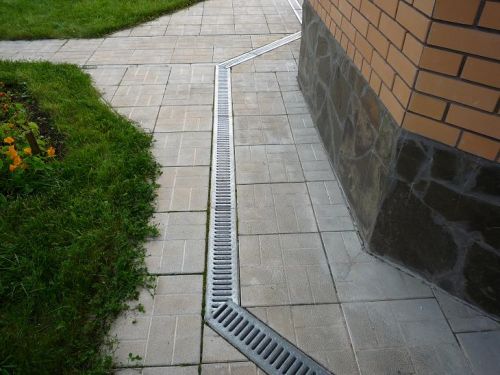
It must be said that cases of damage to the sewer pipeline due to land works are not so rare. They happen even more often than damage to water pipes or power cables.
Random accidents are due to the fact that the work foreman simply does not know that a pipeline passes here. The point here is some discrepancy between the laws. So, for example, when laying power lines or building water pipes, the operating organization is obliged to install warning signs.
But the obligatory installation of a sign warning that a sewerage security zone is located here has not been regulated by law. That is, there is no clear indication that the owners of sewerage networks must mark the location of the buffer zone with signs, in the law.
Thus, if as a result of some work the sewer pipeline was damaged, then the responsibility will be borne by:
- In the absence of a warning label - the operating organization.
- If the sign was present, but was ignored, then the responsibility lies with the contractor.
For damage to sewerage networks, the culprit bears administrative responsibility. If the accident caused damage to the environment, then the measure of responsibility will be different.
Advice! Before carrying out earthworks or other potentially dangerous work for the pipeline, it is necessary to study the area. Information on the location of sewer protection zones can be obtained from an organization that maintains water and sewer networks.
Sizes of sewer protection zones
Regulatory requirements regarding the size of buffer zones need to be known not only to the foremen. Indeed, today, quite often, homeowners build their own local sewer systems, while it is necessary to comply with accepted norms and parameters that are regulated by SNiPs.
Advice! Documents that regulate the rules for the construction of sewer systems:
- SNiP 40-03-99;
- SNiP 3.05.04-85;
- SNiP 2.05.06-86.
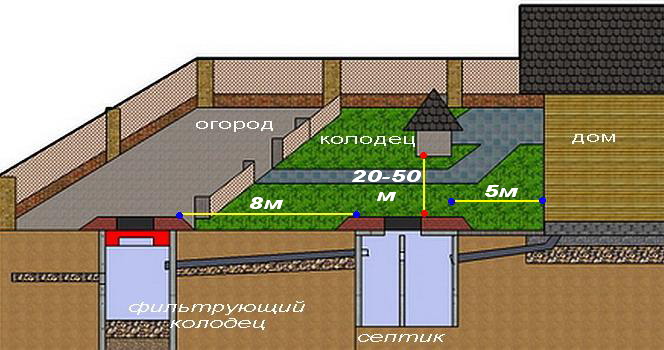
However, you should be aware that SNiPs are set only General requirements, the exact dimensions are set by local authorities. Under normal conditions, the security zone of gravity and pressure sewers is 5 meters on both sides of the pipe. The measurement is made from the side wall of the pipeline.
There are also special conditions that may affect the size of the protected zones, such conditions include:
- High seismic hazard;
- Extremely low temperatures in winter;
- Weak or overly wet soils.
In such difficult conditions, the security zone is doubled and is 10 meters in each direction from the side walls of the pipe. Similarly, a security zone is established storm sewer.
Rules for the location of sewers in relation to water sources
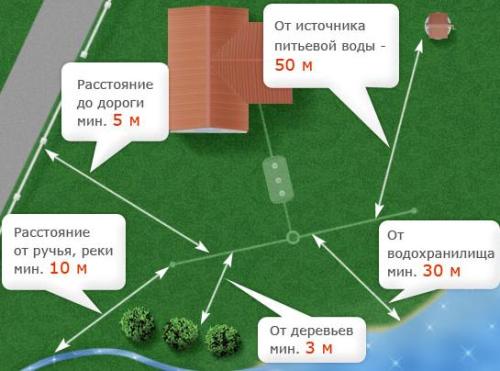
Since damage to sewer systems is a serious threat to the environment, there are strict rules for the placement of the sewer pipeline in relation to water sources.
The sewerage pipeline should be located at a distance:
- At least 250 meters from the river.
- At least 100 meters from the lake.
- At least 50 meters from underground sources.
- At least 10 meters from the water supply pipeline, provided that the pipe diameter is less than a meter. If the pipe diameter is larger, then the distance should be at least 20 meters.
- If the water supply is located in permeable or highly moistened soils, then the distance to the sewer pipes should be at least 50 meters, regardless of the size of the pipe.
Important nuances
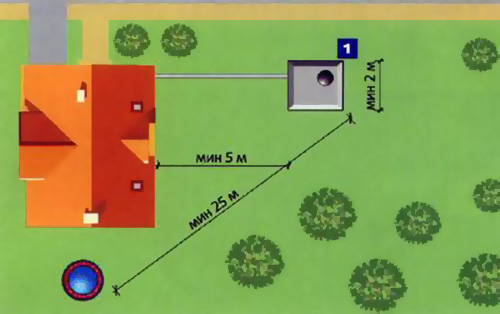
A careful study of the requirements of SNiP is important, both for those developers who are engaged in laying sewers, and for those who plan to carry out some work in a protected area. However, when studying SNiPs, one should not forget about the requirements of local legislation.
Of course, when it was approved, the same SNiPs were taken as the basis, however, there may be some nuances, non-observance of which can lead to trouble for the developer. Developers should take into account the fact that local legislation will still take precedence in legal proceedings.
If, according to the plan, the sewerage pipeline will pass near any buildings, then laying should be carried out at a distance from their foundation, provided for by sanitary standards. Reduction of this distance is possible only upon receipt of the written consent of the owner of the building to carry out the work.
Protected water supply zones
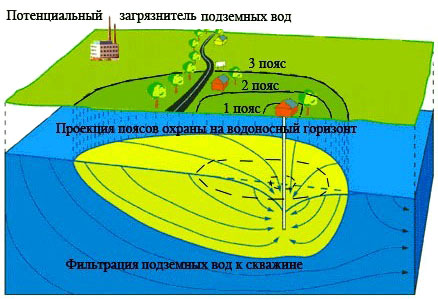
The protection zone of the water supply is being built in order to protect the source of drinking water from possible pollution. Therefore, during the construction of a water supply system, measures are taken that are aimed at eliminating situations that could lead to a deterioration in the quality of the water supplied.
Belts of the water protection zone
The sanitary water supply zone consists of three belts. The design of the zone must be coordinated with the sanitary and epidemiological service, the Vodokanal enterprise and other interested organizations.
- The first belt of the buffer zone is a circle centered at the water intake point and having a radius of 30-50 meters. If there are several sources, then you need to allocate several security zones.
Advice! If it is necessary to reduce the radius of the first security zone, it is necessary to contact the sanitary and epidemiological control service, since this issue is within the competence of this body.
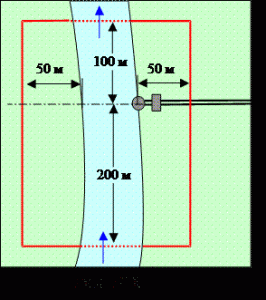
The width of the buffer zone along the pipelines through which water is transported is determined depending on the type of soil.
- If the pipeline is laid in dry soils, then the width of the protection zone is 10 meters in each direction if the pipe diameter does not reach 1000 mm, and 20 meters in each direction if a larger diameter pipeline is being built.
- When constructing a water pipeline in wet ground, the size of the protection zone is 50 meters in each direction, regardless of the diameter of the pipe used.
Advice! In the event that the water supply will pass through already built-up areas, then it is allowed to reduce the territory of sanitary zones after agreement with the SES services.
What should not be in the sanitary zone of the water supply?
In the sanitary protection zone there should not be:
- Latrine, manure storage, garbage bins and other sources of potential water pollution.
- It is forbidden to conduct water conduits through the territory of landfills, sewage filtration fields, irrigated agricultural fields, cattle burial grounds and cemeteries.
So, the water supply and sewerage protection zone is the territory allocated to protect pipelines from damage during earthworks. In addition, the sanitary zone of the water supply system serves to protect the source of water supply from pollution, and the sewerage protection zone is necessary to prevent pollution of the soil by sewage.
Probably, many of you in your life have come across signs with inscriptions of protected areas. But not everyone knows that there is such a thing as a sewerage security zone. It would seem that there is no need to protect the territory adjacent to the sewer networks. However, any action in this area can lead to disastrous consequences. What are the consequences, and what measures exist to protect drainage networks, we will tell in our article.
Sewer protection zones are areas that surround sewer network buildings, water bodies and airspace, where the use of certain actions or immovable objects is limited in order to ensure the protection of sewerage systems.
In such areas, it is necessary to refrain from such actions that contribute to damage to the buildings of the sewer system:
- plant trees;
- obstruct the passage to the communication facilities of the outlet network;
- produce a warehouse of materials;
- engage in construction, mine, explosive, pile work;
- produce without the permission of the owner sewer network lifting work near buildings;
- carry out near networks located near water bodies, moving soil, deepening the bottom, immersing solids, pulling logs, chains, anchors of water vehicles.
The security zone + sewerage have their own boundary limits, which are set taking into account:
- location;
- appointments;
- building diameters;
- laying depth.
As a rule, the boundaries are prescribed in a regulation issued by the Minister of the Environment, but exact information can be obtained from local authorities or water and sewer organizations.
Consequences of not knowing the existence of protected areas
In our lives, we can often encounter damage to the external parts of the sewer system, which exceed the number of cases on communication lines, electricity or water supply.
This happens because the manufacturers of construction and earthworks carry out actions without knowing that there is a security zone for sewer networks in this area, while causing damage to the drainage system.
What is the reason for such ignorance? Installation of warning signs about the presence on the territory, for example, of a pipeline or cable, is the responsibility of the organizations that operate this facility.
Cases of installation of watermarks are prescribed in the Water Code, special signs - in other regulations and laws.
But the case of installing a sign that the security zone of the sewer collector is located on the territory has not been documented.
As a result, in case of damage to communications, the operator bears responsibility if the sign is not installed, and if the sign is ignored, the work foreman. It is not legally established that the owners of sewer networks must mark the territory of the buffer zone with signs.
Attention. However, in case of damage to sewer networks and buildings, the foreman is subject to administrative liability by law (Administrative Code, art. 7.7).
This is about direct damage. sewer facilities.
If the actions of the works foreman, in addition to damaging the system, led to a detrimental impact on the environment, then this is another type of offense that carries a different kind of liability.
Warning
Advice. So, in order not to get into a difficult situation that entails serious trouble, you should thoroughly study the area where a certain type of work is planned.
An analysis of the area for the presence of sewer mains and protected areas can be obtained from the local water supply and sewer organization.
It is best to familiarize yourself with a copy of the plan. Provided that the protected zone is present on the territory, a permit must be obtained to carry out the work.
Regulatory requirements for the use of protected areas
What actions can be carried out near sewer networks, and which are prohibited? Regulatory requirements on these issues are regulated by SNIP (40-03-99; 3.05.04-85; 2.05.06-85).
Attention. Sanitary norms and rules determine the general requirements and standards. Region-specific values and rules are established by representatives of local governments.
Under normal environmental conditions, the pressure sewer protection zone to the sides of the sewer is 5 m.
According to the resolutions of city water supply and sewerage organizations, a security zone is established in open areas, street passages:
- near networks not exceeding a diameter of 600 mm - 5 m from the outer walls of the pipeline or the extreme protruding point of the structure;
- near highways exceeding a diameter of 1000 mm - 10-25 m from structures or communication pipes, depending on the purpose of the network and soil.
The following works are prohibited on the territory of the protected zone:
- engage in the construction of temporary or permanent structures;
- arrange parking for road transport;
- arrange dumps;
- plant shrubs and trees at a distance of less than three meters from the pipeline;
- raise or lower existing level soil by cutting or backfilling;
- to equip a pavement of a temporary or permanent nature from reinforced concrete slabs;
- use percussion mechanisms near the network sewerage facility (the possibility of use is at a distance of 15 m);
- block free access to sewerage facilities, wells, networks;
- to lay the subway at a distance of less than 20 m from the existing sewer collectors.
Responsibilities of the Work Foreman
workers sewer systems are the key to good life support for urban citizens, therefore, when carrying out work on the site of the buffer zone, the organizer of these works is obliged to:
- adhere to strict adherence to rules and regulations;
- ensure the safety and integrity of sewer structures in the area of work performed;
- in case of detection of inconsistencies in kind with the analysis provided by the water supply and sewerage organizations, take precautionary measures and suspend the work until a subsequent decision;
- timely remove snow, ice, debris to ensure free access to sewer facilities;
- when handing over the object, invite a representative of the body that issued the permit to the commission.
These measures apply to contractors operating in open areas.
Guard zone size
As we described above, according to SNIP, the security zone under normal conditions is equal to a 5-meter mark from the side walls sewer pipes.
This value is applicable for self-flowing and pressure drainage systems. In addition, the size of the buffer zone is affected by special environmental conditions.
These include:
- high seismic hazard of the site;
- low average annual temperature regime a certain region;
- high humidity or weak soil.
Usually, local authorities apply in this case an increase in the five-meter value.
The storm sewer security zone is established in a similar way. For your information: storm sewers are designed to receive conditionally clean industrial and atmospheric Wastewater that do not require cleaning before removal.
If we judge the damage to the storm sewer, then it can lead not only to correct use buffer zone, but also technical violations in this type.
Advice. So, when installing storm water, and, by the way, other types of sewage, it is necessary to comply with the existing requirements and specifications. As with any work, some deviations and defects are possible, but their size should not affect the performance of the sewer system.
Preservation of water protection zones
We figured out the moments of ensuring the safety of urban sewer networks.
In order to prevent damage to water protection zones, the norms of SNIP provide that sewerage in a water protection zone should be located in the following way:
- from the edge of river waters at a distance of 250 m;
- from the lake shores - 100 m;
- from underground water sources - 50 m.
The requirements for the mutual placement of drainage and water supply networks are also defined:
- distance 10 m for water networks, the diameter of which does not exceed 1000 mm;
- a distance of 20 m for water pipes with a large diameter;
- a distance of 50 m in the case of wet ground, while their diameter does not matter.
Advice. It is better to lay sewerage on the territory of protected water bodies with a 10% margin of distance from the required standard indicators.
This is due to the frequent discrepancy between the establishment of protected zones in nature and the schematic plan for their placement.
In conclusion, I would like to note that the organizers and producers of work should be attentive to the requirements of SNIP and do not forget about the decisions of local legislators, which also refer to general requirements.
When violations are detected, the regulatory authorities have the offenders to present claims.
All of us cannot but worry about the quality of water in the water supply, which we drink and use for household needs. Cleanliness should be taken care of both at the head facilities where water is drawn in and in water supply networks. It is necessary to protect not only water intake from pollution, but the protection zone of the water supply system along its entire length must fully fulfill its function.
For the purpose of environmental protection, a sanitary protection zone (ZSanO) is being created around all water supply facilities.
Sanitary-protective zoning involves the formation of 3 belts:
- strict regime - No. 1;
- restrictive - No. 2;
- observant - No. 3.
In a strict regime, the water intake facilities and the place of water intake are protected directly from accidental or intentional harm. The second restrictive belt is designed to protect the water source from microbial pollution, and the third observation belt is needed to control the level of chemical pollution.
The source of water is located in the territory of a strict regime, followed by the belts of restrictions and observations, which have their own rules
If the first zone can be outlined manually, using a small number of standard figures, then the second and third belts are determined as a result of complex hydrodynamic calculations using a difficult method. Much easier to learn computer program AMWELLS, meanwhile we'll take a look general principles construction of sanitary protection zones in several versions.
1. For open source water supply
Let's say the water in the water supply comes from the river - this is an open (or surface) source. The first belt is determined by the location of water intake structures (head elements of the water supply system). To them we add 180-200 meters upstream and 90-100 m downstream. The water intake and the water area adjacent to it are controlled by paramilitary guards; it is forbidden to have unauthorized people here.
Having decided on the length, let's find out the width of the coastal strip that falls into the ZSanO. There may be 50 or 200 m with the capture of the opposite bank, which depends on the power of the river itself. Along a large and deep channel with an intense current, no more than 50 m of the coast is isolated on both sides. And if the river is small - a total of up to 150 m and more. This includes the width of the two coastal edges and the river itself.
When water is taken from a large lake, a reservoir, when it is very far from the opposite shore, 100 m are measured in all directions. It turns out like a circle with such a radius, and some part of it passes through the water. The water boundary of the zone is marked with buoys and illuminated buoys.
The second belt is the territory that immediately follows the first belt and adjoins it. There are severe restrictions on it: factories and industrial production, farmland, construction, improvement of beaches and places of mass country rest. To know where to locate the boundary of the second belt upstream, it is necessary to study the ability of river water to self-purify.
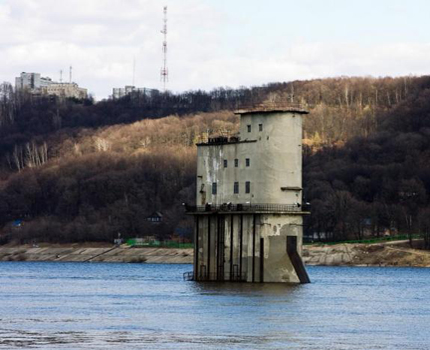
The water intake structure consists of receiving windows, a suction chamber, a pumping station of the 1st lift, a service pavilion that accommodates personnel, and an observation gallery
On average, the river processes the pollution that has fallen into it from 3 to 5 days. During this time, the river flow should not have time to carry the polluted water to the water intake point, self-purification should occur earlier. If translated into mileage, then it is quite enough to include in the second belt 20-35 km of the channel for large and 35-60 km for small rivers above the water intake.
And downstream the border will pass at a distance of 250-300 m from the water intake. Here it is required to exclude the reverse movement of water against the current due to the wind.
The third belt - cities, towns, villages supplied with water from this source fall into it, the territory needs constant monitoring, but there are no such restrictions as in the first and second.
2. For water supply from an underground source (well)
In the version with an underground source, a sanitary protection zone is also needed. For shallow water wells penetrating sedimentary aquifers, the strict regime zone is surrounded by a radius of 50 m, and for deep wells reaching aquifers in bedrock, this figure is half as much - 25 m.
There can be no unnecessary structures here, except for the primary pumping station, water tower, and a minimum of ancillary buildings. Surface and drainage runoff must be taken outside, and the territory itself should be landscaped, planted with greenery, surrounded by a fence, while at the same time providing unhindered access for special vehicles with maintenance teams to eliminate possible sudden malfunctions, planned maintenance and repair of equipment.
The second belt is defined so that pollution from outside it cannot penetrate into underground aquifers and reach water intake within 100 to 400 days - a specific figure is calculated based on the laws of hydrodynamics, taking into account the characteristics of soils and climatic factors.
The third belt is a zone of active human activity. It is assumed that the movement of pollution from this area towards the water intake will be slow and will take more time than the planned life of the well (25-50 years).
Sanitary protection zones are drawn on maps, information about them is published, and the strict regime belt is marked with all sorts of warning signs and signs on the ground, surrounded by a solid fence, a net with barbed wire, etc.
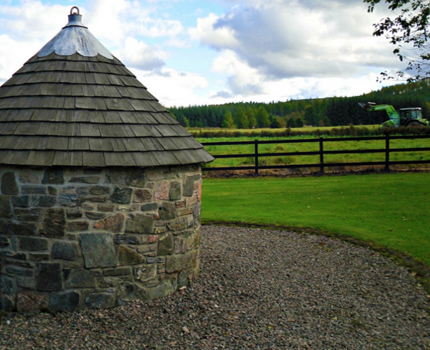
The well is closed with a decorative warm house, the adjacent territory of the strict regime is fenced around the perimeter, landscaped and kept in perfect order
3. For structures and conduits outside the water intake
Outside the territories related to the intake of water from sources, there are zones of sanitary protection of a strict regime around such waterworks:
- spare tanks, filter stations - 30 m;
- water towers - 10 m;
- pumping units, warehouses for chlorine and reagents, settling tanks, etc. - 15 m.
Sanitary lanes must be laid along the water conduits both on the left and on the right. Their width varies from 10 to 50 m and depends on how high the groundwater rises, what is the diameter of the conduit pipes. If the pipe section does not exceed 1 m, a strip 10 m wide is sufficient, for a pipe with a diameter of more than 1 m, the strip width is doubled, and at high ground water ah - up to 50 m, regardless of the size of the pipe.
When a water pipeline is laid through already built-up areas, it is allowed to reduce the area of protection zones, if the sanitary and epidemiological service does not object.
What is prohibited in the ZSANO
The most stringent requirements are imposed on strict regime zones (the first belt). On their territories, it is forbidden to erect buildings and structures, dig trenches or otherwise go deep into the ground, store any materials, apply fertilizers, litter, cut down green spaces, graze livestock, fish, equip moorings for boats, swim.
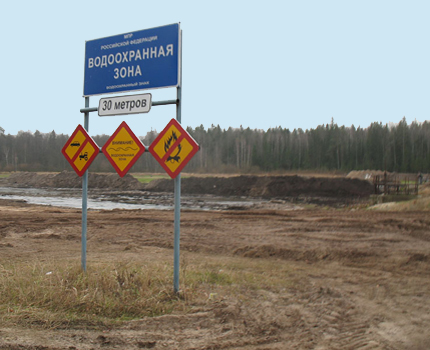
Prohibition signs are attached next to the warning sign, indicating that it is strictly forbidden to do in the sanitary protection zone
An extensive list of prohibitions has been compiled for the second security belt. Construction and blasting, pile driving and other activities that create vibration are prohibited. It is impossible to dump wastewater, develop the bowels of the earth, cut down forests, place warehouses for pesticides, fertilizers, fuels and lubricants, plow up virgin lands, and drain swamps.
It is not allowed to allocate places for cattle burial grounds, silo and manure pits, livestock and poultry complexes, etc. The use of the protected area for living, active recreation, and sporting events is excluded. It is forbidden to pull water conduits along the territory of landfills, filtration fields, near cemeteries.
How to lay a sewer in relation to the water supply
Accidents on sewer networks are a frequent occurrence, and the reason for this is not only the natural wear of pipes and systems. Sewerage, like water supply, has a security zone, but it is not customary to designate it with signs and signs. The presence of sewer pipes and their location can be judged by wells closed with massive metal covers marked "K" or "GK".
Before you start excavation in the security sewer zone, it is necessary to study the plans and schemes of engineering communications, obtain appropriate recommendations and expert advice.
Otherwise, it is easy to break a sewer pipe with one careless push of an excavator bucket, and then who will calculate the losses and material costs for restoration? And if there is a water supply nearby, then the damage and negative consequences increase many times over.
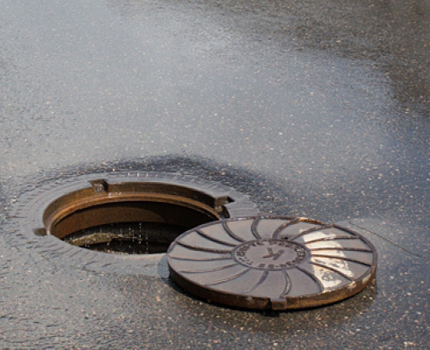
The letters "K" or "GK" on the cover manhole designate the sewerage or city sewerage respectively, on the cover of the water well should be written "B"
The security zone of sewerage networks is established in proportion to the pipe section:
- up to 0.6 m in diameter - not less than 5 meters in both directions;
- from 0.6 to 1.0 m and more - 10-25 meters each.
It is necessary to take into account the seismological characteristics of the area, climate and average monthly temperatures, soil moisture and freezing, and soil features. The presence of unfavorable factors is a reason to increase the buffer zone.
The distance to sewer networks located underground from such objects is also regulated:
- sewerage should be 3-5 meters away from any foundations (for pressure, the distance is greater than for gravity);
- from supporting structures, fences, flyovers, the indentation is from 1.5 m to 3.0 m;
- from the railway track - 3.5-4.0 m;
- from the road curb on the carriageway - 2.0 m and 1.5 m (standards for pressure and gravity sewerage);
- from ditches and ditches - 1-1.5 m from the near edge;
- street lighting poles, racks of contact networks - 1-1.5 m;
- supports of high-voltage power lines - 2.5-3 m.
The numbers are reference, accurate engineering calculations allow you to get more reasonable data. If the intersection of water and sewer pipes cannot be avoided, the water supply should be placed above the sewer. When it is technically difficult to implement, a casing is put on the sewer pipes.
The space between it and the working pipe is tightly packed with soil. On loams and clays, the length of the casing is 10 meters, on sands - 20 meters. It is better to cross communications for various purposes at a right angle.
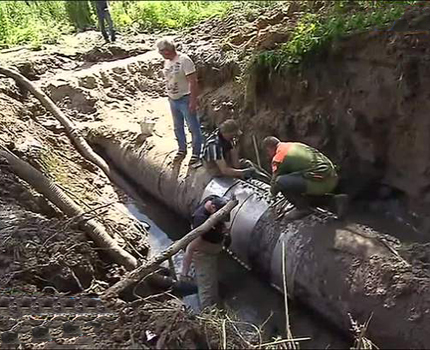
With a large-scale breakthrough of the sewer, it is necessary to turn off the supply tap water so that, if not stopped, then at least reduce the release of fecal water to the outside
When opening water and sewer pipes in connection with repairs, it is allowed to use equipment in earthworks to a certain depth. The last meter of earth above the pipe is removed carefully by hand without the use of a tool with shock and vibration action.
It is strictly forbidden during laying to touch the sanitary zones of water pipes with sewage, but in the city the requirements are less stringent. In urban conditions, with a forced parallel arrangement of main water and sewer pipes, it is necessary to maintain the following distances:
- 10 m for pipes up to 1.0 m in diameter;
- 20 m with a pipe diameter of more than 1.0 m;
- 50 m - on wet ground with any pipe diameter.
For thinner domestic sewer pipes, the distance to other underground utilities is determined by their own standards:
- to the water supply - from 1.5 to 5.0 m, depending on the material and diameter of the pipes;
- to rain drainage systems- 0.4 m;
- to gas pipelines - from 1.0 to 5 m;
- to cables laid underground - 0.5 m;
- to the heating plant - 1.0 m.
The last word on how to ensure the safe coexistence of water supply and sewerage, remains with the specialists of the water utilities. All controversial issues should be resolved during the design process and not come up at the operational stage.
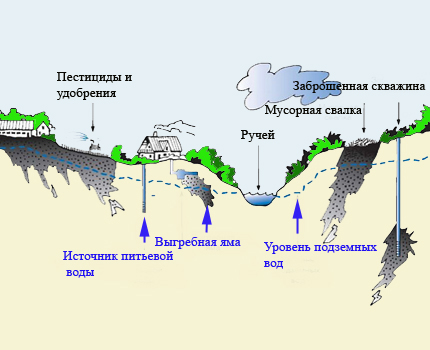
If you do not control domestic and industrial wastewater, landfills, the amount of chemical fertilizers and poisons in the fields, water supplies will become unusable
List of regulatory documents
The obligatory creation of a ZSanO, broken down into zones, is provided for by the law “On the sanitary and epidemiological welfare of the population” (No. 52FZ, 30.03.99). According to this law, the development of the ZSanO water source must be attached to the project for the operation of the water supply system and formalized as a separate project.
The design of the ZSanO is based on SanPiN with the code 2.1.4.1110-02. This regulatory document defines how to calculate the sanitary protection zones, and describes the requirements for them from the standpoint of sanitation and epidemiology. Ignoring the rules and norms prescribed in SanPiN 2.1.4.1110-02 is fraught with a high probability of outbreaks of serious infectious diseases, mass poisoning, epidemics.
Documents with the abbreviation SNiP will also be useful: 40-03-99 ( new version 2.04.03-85), 2.07.01-89*, 2.07.01-89*, 2.05.06-85*, 3.05.04-85*, 2.04.02-84 (Section 10 – Sanitary Protection Zones). In building codes and regulations with the indicated codes, you can find the necessary information on the design of water and sewer networks, on the development of settlements, on main pipelines.
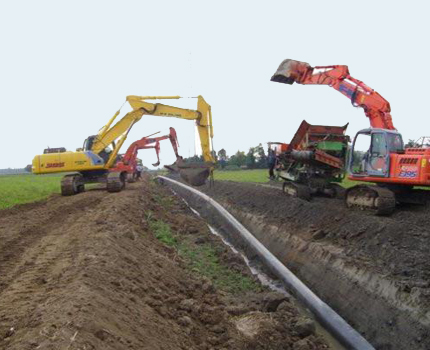
The standard for the depth of laying the water supply system is at least 0.5 m from the upper level of the pipe, excluding soil freezing in winter. To the left and right of the trench there is a land allotment for a 10-20 m wide sanitary security strip
Normative materials are the basis for the development of norms, taking into account the local characteristics of a particular region. Approval and adjustment of norms for Sano are carried out by urban and rural administrative authorities.
Responsibility for non-compliance with security rules
Protected zones are a kind of guarantee of the purity of water and its protection from pollution. All business entities and individuals are required to comply with the rules in force in these zones. The following sanctions are provided for violation:
- compensation for damage - the culprit must compensate for the damage caused by unauthorized construction, storage and storage of materials, accumulation of garbage and waste closer than 5 m from the water supply;
- administrative measures, i.e. fines - for neglecting building codes, rules, for the construction of buildings and any other construction without a project approved in advance;
- criminal liability for squatting land plots in sanitary protection zones.
It is foolish to justify as an excuse that you did not know about the location of the security zones - this does not relieve you of responsibility. Before performing any construction, land and other work, you should contact the water utility and find out where the security zones are located in your settlement and its environs, and what actions cannot be carried out in the chosen place. This is the only way to avoid unpleasant and unexpected consequences.
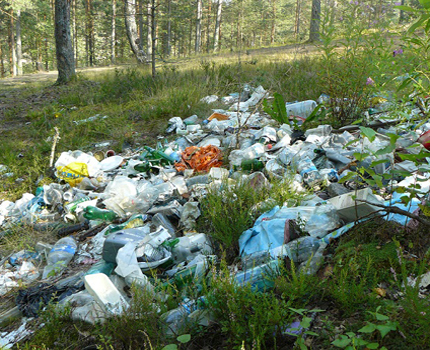
It is not always possible to catch those who throw garbage in the water protection zone at the crime scene, and it remains only to appeal to the conscience and consciousness of all citizens
Since the first zone of the ZSanO must be marked with warning signs, in the absence of them, the responsibility for order in the buffer zone lies with the operating organization, and there is no reason to make claims against those who accidentally intrude into the forbidden territory. But if there are warnings, the violator will not be able to absolve himself of guilt for illegal entry into the sanitary zone and the implementation of any actions there.
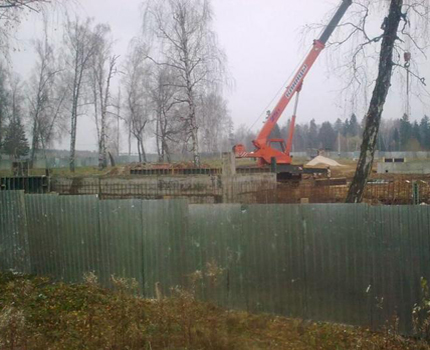
Land swindlers who arbitrarily seize plots in the sanitary protection zone for construction can only be fought by toughening penalties and moving from administrative to criminal liability
The legislation of the Russian Federation determines the degree of responsibility and punishment for those who violate sanitary norms, requirements. You can read about this in the Code of the Russian Federation "On Administrative Violations" (No. 195FZ, December 30, 2001). In particular, Article 8.13 deals with water bodies and their protection.
Fine for violations in the zones of sanitary protection of water pipes and water intakes ordinary person it is possible for an amount from 500 to 1 thousand rubles, an official - for 1-2 thousand rubles. Fines for legal entities range from 10 to 20 thousand rubles.
If damage is caused to the sanitary protection zone of a reservoir, lake, river involved in water supply, then the fines are higher - 1-2 thousand rubles, 3-4 thousand rubles and 30-40 thousand rubles, respectively. Compliance with the rules and regulations under the legislation of the Russian Federation is strictly checked.
Video about the organization and calculation of security zones
What does the strict regime sanitary protection zone look like:
How does the program for calculating the zones of sanitary protection of underground water intakes work:
To sum it up… Security zones - important condition in building water supply systems. And they must fully fulfill their functional purpose, if we want to water taps fled pure water. When filtration stations on water pipes cannot cope with the level of pollution, chlorine, which is harmful to health, is added to the water for disinfection. Isn't it better to remember about the environment and not disturb the order in the sanitary protection zones?
Everyone has come across in life signs “Cable security zone” or “Sanitary protection zone of a reservoir”. But not even all builders know that there is also a sewerage security zone. At first glance, the question is logical: “What is there to protect?”. However, sometimes this ignorance can lead to backfire– both owners of private houses and officials of various assembly organizations. Read on to find out how to avoid this.
Damage to external sewerage networks is not such a rare phenomenon. And it occurs with a frequency even greater than on the mains of water supply, electricity or communications.
In this regard, earthworks producers - both legal entities and owners of private land holdings, digging trenches and foundation pits, have a greater risk of damaging the drainage system than other communications.
Because they do not know that in this place there is a security zone of sewer networks. What is it connected with?
Obligations of owners and operating organizations to install warning signs about the passage of underground cables or pipelines in a given place, the border sanitary zone reservoirs are directly prescribed in the regulations. In the case of water management, this is the Water Code. In the rest - special laws and regulations.
And only for the sewerage system such requirements are not regulated. As a result - if other communications are damaged, but there was no warning information in this area - the one who did not install the sign is responsible. And the foreman is to blame if there was a corresponding plate, but he ignored it.
The situation with drainage pipelines is much more complicated. Here, for some reason, legislators have not established clear standards, and network owners are not required to somehow designate sewerage protection zones.
Nevertheless, from the point of view of the legislation, damage to sewer equipment is an administrative offense.
Note! The Administrative Code reads: “Article 7.7. Damage to objects and systems of water supply, sewerage, hydraulic structures, devices and installations for water management and water protection purposes
Damage to objects and systems of water supply, sewerage, hydraulic structures, devices and installations for water management and water protection purposes shall entail the imposition of an administrative fine on citizens in the amount of one thousand to one thousand five hundred rubles; for officials - from two thousand to three thousand rubles; for legal entities - from twenty thousand to thirty thousand rubles.
At the same time, it should be noted that the article speaks only about direct damage to systems and structures. If at the same time there were harmful effects on the environment, this will be another offense, perhaps not one. Yes, and the damage caused to the perpetrator will have to be compensated. So it is quite possible, doing your own thing, and not intending anything bad, to get into serious trouble.
Precautionary measures
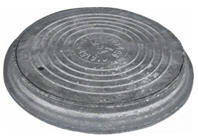
Given the possible negative consequences, it is worth trying to prevent their occurrence. If you are going to carry out earthworks, you should study the surrounding area.
The main sign of the presence of various sewers is manhole covers with a characteristic large letter "K". Coordinate plates or paint markings can also give it away.
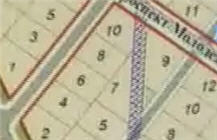
But even if they are not found, it is better to play it safe and contact the local water utility. There are diagrams of all sewer mains, which indicate whether or not a security zone of a sewer collector or other structure is located on a given site.
Moreover, in order to avoid subsequent inconsistencies, it is better to ask for a certified copy of the plan. If it turns out that the buffer zone is still present there, you can immediately apply for a work permit. Without such permission, it is impossible to carry out work near the sewer.
Protected zone sizes
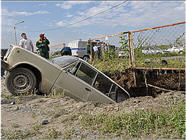
It is useful to know the regulatory requirements for the size of sewer protection zones not only in order not to accidentally damage pipelines. Indeed, often construction companies or homeowners organize their own. And at the same time, they are also required to comply with the established parameters. They are regulated by the requirements of several SNiPs.
Note! Documents regulating the rules for sewerage:
SNiP 40 - 03 - 99 "Sewerage, external networks and structures",
SNiP 3.05.04 - 85 * "External networks and water supply and sewerage facilities" and SNiP 2.05.06 - 85 " Main pipelines. Building regulations".
However, SNiPs set general standards, specific figures are set by local representative authorities - legislative assemblies, etc.
Under normal conditions, the pressure sewer protection zone is 5 m in each direction from the edge of the side wall of the pipe. The same applies to the gravity drainage system.
TO special conditions factors affecting the size of sanitary protection zones include the low average annual temperature of the region, high seismic hazard, weak and waterlogged soils, and other conditions specified in SNiPs. As a rule, in such cases, the POP increases to a distance of 10 m 5 m in each direction from the edge of the side wall of the pipeline.
In the same way, a storm sewer security zone is arranged.
Sewer protection
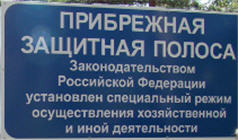
Sewerage is a source of increased risk of pollution for water pipes and water supplies. Therefore, not only buildings and roads must be carried away from it at a certain distance. Drainage networks also cannot be located closer than certain distances to water arteries.
And the numbers are impressive. Sewerage in the water protection zone should be located at a distance of at least: 250 m - from the water edge of the rivers, 100 m - from the lake shore, 50 m - from underground water sources.
Sufficiently stringent requirements are also imposed on the mutual arrangement of water supply and drainage pipelines. This is 10 m for a water pipe with a diameter of up to 1000 mm, 20 m for large diameters, and 50 m - if the pipes pass in wet soil, while the diameter does not play a role.
Advice! It is better to arrange sewerage in the zones of sanitary protection of water supply facilities with a distance margin of 10% or more from the regulatory requirements. It is not uncommon for the measurement data, and even the hole punching of the developer and the water supply organization, to differ. According to the data of the water utility, the sewerage system captures the territory where the security zone is established, but according to the builders, it does not. As a rule, the last word remains with the watermen.
Careful planning and accurate placement of the project on the ground should be given the closest attention. After all, the transfer of the finished sewer network will be very expensive in any case, and sometimes it is simply technically impossible.
Its operation cannot be carried out categorically, since even this fact itself, even in the absence of an accident, is already an offense, and even if pollution of a water supply facility has occurred sewerage– it can even be about criminal liability.
Important nuances
Careful attention to the requirements of SNiPs is mandatory both for sewerage operators and for those who carry out any work or build objects in the sewerage buffer zone or its environs.
However, be aware of local laws. In general, it is based on the same SNiPs, but in some subjects it is possible own settings which may come as an unpleasant surprise.
You should refer to these documents (for example, for the capital, this is Decree of the Government of Moscow dated August 17, 1993 N 798 “On Approval of the “Rules for Using the Moscow City Water Supply and Sewerage Systems”), and take into account their requirements when performing work.
Often disagreements over the distance between the water conduit and the sewerage system arise due to the fact that according to “SNiP 2.07.01-89 * “Urban planning. Planning and development of urban and rural settlements” the regulated distance between the water supply and pressure sewer networks and the foundations of buildings and structures is 5 m.
Many developers are guided by this figure, and come under fire from the sanctions of the water utility. The fact is that this SNiP indicates the minimum allowable distance. And the dimensions of the security zone of the highway are regulated by SNiP 2.04.02-84 and SanPiN 2.1.4.1110-02, and their dimensions are indicated above in this article.
Law enforcement practice shows that priority in the case of legal proceedings remains with the latest documents.
Those who lay a drainage pipeline near buildings and structures also risk getting into a difficult situation. In these cases, it must be performed from them at a distance established by the regulations borders of the sanitary zone, the reduction of this distance is possible only with the written permission of the owner of the object. And in this case, employees of local water utilities periodically try to find violations.
Security zones are regulated by special regulations, standards and rules for the use of resources. For water intakes, conduits and water pipelines, there are special sections of SanPiN, which include environmental and sanitary and hygienic rules. In particular, the SanPiN 2.1.4.1110-02 document regulates the operation of a water pipeline located in a protected zone. The prescribed rules have a legal form and apply to all citizens, as well as legal entities.
What is a security zone?
With regard to the water supply, security measures aim to implement a set of measures aimed at minimizing resource pollution. This may refer to different types water supply networks and channels - including underground, surface and artificial. At the same time, there is a classification of zones according to belonging to different belts. For example, the first belt covers water intake facilities, water supply channels and platforms. plumbing structures. It is designed to prevent the risks of intentional or accidental damage to structures and direct water pollution. The second and third belt zones are also called restricted areas. These are places where measures are in place to prevent pollution of water sources. At the design stage, a list of protective measures is prescribed for the sanitary protection zones of water supply sources. As a rule, they are guided by the development and implementation of rules aimed at maintaining the optimal chemical and biological condition of water supply channels.
Factors for determining the protection zone
One of the key factors is the distance of pollution spread. It is defined by the following parameters:
- Type of water supply source (underground or surface).
- The level and potential of natural protection against pollution.
- Characteristics of pollution - biological, chemical and microbial.
- hydrogeological conditions.
When developing a project and determining the boundaries of a particular zone, specialists also take into account the current composition of the water and the time required for the survival of unwanted microorganisms in it. The chemical processes in the environment served by the water supply are also taken into account. The buffer zone is also characterized by temperature indicators, adsorption and physical processes. Together, these and other characteristics make it possible to determine the optimal boundaries for a protected area with the assignment of the status of a belt to it.
What is protected water supply?
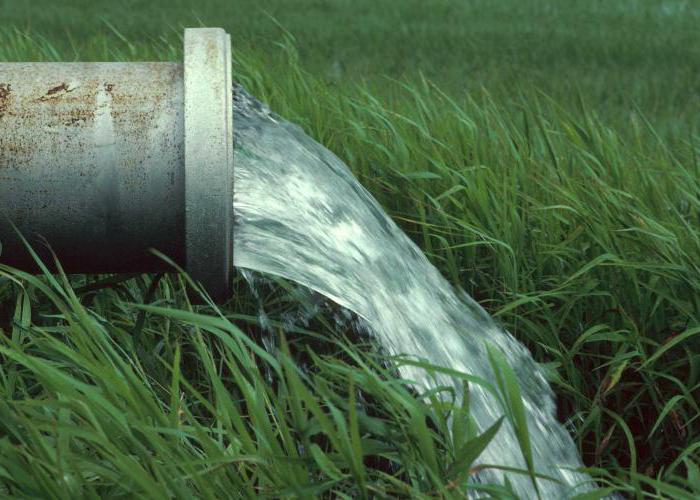
Despite entering the buffer zone, the water supply is not an object of the reserve without a practical functional purpose. Technically, it fulfills its primary tasks of water supply to consumers. The purposes of such water supply can be technical, household, industrial and food. The water supply complex includes engineering communications, pumping stations, purification, pressure and filtration facilities. Depending on the source of supply, closed underground tunnels with pipes, surface open flumes and tanks for temporary or permanent water storage can be used. Again, the zones of sanitary protection of water supply sources are initially designed taking into account the technical part of the implementation of the facility. Design solutions are calculated for more efficient use of the resource, as well as the characteristics of the equipment used. For pipelines, materials such as steel, asbestos and reinforced concrete, and in some cases wood can be used.
Types of water pipelines of the buffer zone
There are local local and main water pipelines located in the protected zone. As a rule, belonging to one of these categories is determined by the potential of the source in terms of volumes of water supply. In accordance with this characteristic, the surrounding arrangement of the territory of the buffer zone is also carried out. engineering communications. In addition, a distinction is made between pressure and non-pressure water pipelines. A security zone with communications of the first type involves the inclusion of pumping equipment in the infrastructure or the use of local dams. In the case of non-pressure or gravity water pipelines, the resource is delivered by gravity. This allows you to save on electricity, but there are problems with flow regulation.
Protective measures for underground sources
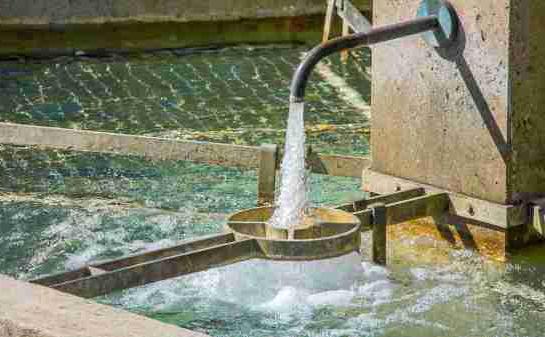
If the object is located in the first security zone, then protective measures are mainly focused on the elimination of negative impacts on drinking water from manholes, wells and overflow pipelines. Water intake points are equipped with automated control of the composition of water and equipment that regulates the parameters of the water supply system. As regards the second and third belts, one of the main tasks is plugging, detection and, if possible, restoration of old or misused wells. The drilling of new wells is also envisaged, but only upon agreement with the sanitary and epidemiological supervision authorities. There are a number of strict prohibitions that are aimed at the chemical and physical protection of the water supply. The security zone in these belts implies a ban on the placement mineral fertilizers, chemicals and fuels and lubricants.
Protective measures for surface sources
With regard to the first belt of protection, there are restrictions on the discharge of sewage from transport, washing, bathing and organizing a watering place for livestock. It also introduces a ban on other types of water use that affect its qualitative composition. In the case of navigable reservoirs located above water inlets, buoys with a lighting system are placed. The water area is fenced with buoys and warning signs. More stringent measures apply to the second and third belts, in which the water supply protection zone is located. The rules, in particular, regulate the allocation of territories for the construction of agricultural, residential and industrial facilities. A complete ban on such projects is not introduced, but in the process of coordination, the risks of the impact of the activities of future facilities on the characteristics of the protected resource are taken into account. In addition, it is not allowed to discharge sewage in the water intake zone if they do not meet sanitary requirements.
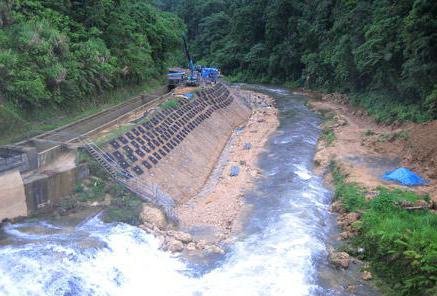
Within the water area, all activities related to the extraction of gravel and sand are prohibited. Depending on the results of the hydrological calculation, a ban on earthworks in the buffer zone of a water supply system operating from surface sources may also be introduced.
Protected zone boundaries
To begin with, it is worth noting that within the zone there are different boundaries depending on the belt. So, the first belt can extend to minimum distances from 10 to 30 m in a radius, depending on the technological structure. For example, the distance from the water tower is at least 10 m, and the filters and control tanks operate at a distance of at least 30 m from the border. In turn, the sanitary protection zone is formed around the water supply protection zone. How many meters is it? It depends on the diameter of the conduit - for example, with a standard size of 100 cm, the indent will reach 10 m, and a diameter of more than 100 cm will determine the border distance by 20 m. Again, we are talking about minimum distances. Depending on other parameters of communications and operating conditions of the zone, these indicators may change upwards.
Area for the sanitary strip
Within the borders of the sanitary belt, construction and economic consumption of water resources are strictly regulated. In this zone, initially there should not be sources with dirty water, which may have an impact on protected water supply channels. Therefore, before the organization of this strip, geodetic studies are also carried out with the analysis of groundwater and soil cover. As well as the construction of a water pipeline in the buffer zone, severe restrictions are introduced on the territory for the development of new agricultural and industrial facilities. It is also prohibited to organize landfills, filtration and sewage fields.
Location of drains in relation to the buffer zone
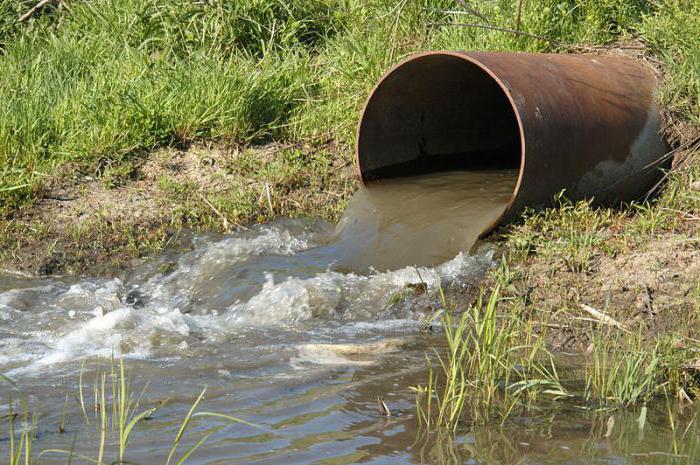
It has already been noted that objects of various purposes that do not pollute water supply sources can be located near protected zones. But in this case, the regulation of effluents and the operation of the sewer channels of these objects are inevitably required. In accordance with the regulations, buildings must be provided with sewage disposal channels to local receivers. treatment facilities or industrial sewer. Regardless of the method of liquidation of wastewater, the relationship between the protection zones of water pipes and sewers is regulated separately. The dimensions of zones with a radius relative to the source of 30-50 m should not be affected by waste from buildings located in the near area. If there is no possibility of third-party sewage disposal in compliance with sanitary and hygienic standards, then the facilities must be equipped with waterproof waste receivers.
Requirements for the characteristics of water in sources
To maintain the optimal state of water in a protected area, regular analysis of its composition is required. In particular, there should be no oily oil films on the surface of the water. In the case of water intended for drinking or domestic needs, the volume of suspended particles should not exceed 0.25 mg per 1 dm3. Separately, the oxygen content in dissolved form is also calculated - not less than 4 mg per 1 dm 3. Methods for visual assessment of the quality of drinking water are also used. So, for example, the color of the water column should not appear at 20 cm. Data for such analyzes are obtained directly from the water supply. The buffer zone is subject to similar studies in accordance with the schedule provided for in the project. Although in the future, depending on changes in the operating conditions of the facility, the regularity of analyzes may vary.
Regulation of the laying of pipeline networks
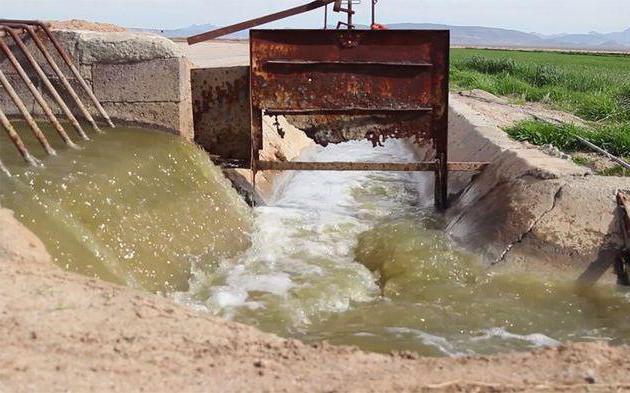
Pipelines for water supply systems are usually focused on serving a clean environment with minimal inclusion of foreign elements. Therefore, in case of compliance with sanitary and hygienic standards, the laying of water pipes is allowed in the first zone of protected areas. But, again, after a thorough study of the sources and consumers with whom he will have to work.
There are also prohibitive measures that completely exclude the organization of third-party networks within protected areas. First of all, it concerns the laying of water pipes for main networks, regardless of the purpose. The same rule applies to other communications that interact with cleaning, industrial or agricultural facilities.
Conclusion
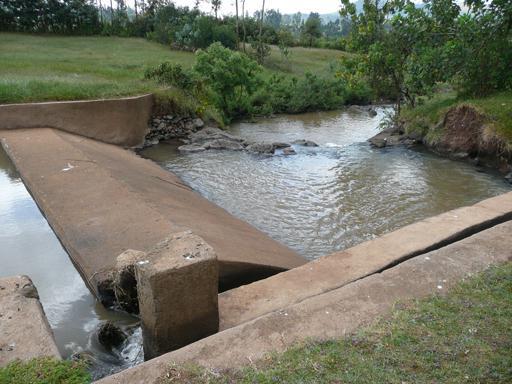
The rules for the regulation of protective measures in the area of operation of a protected water supply system are based on the motives for maintaining the purity of the water resource. The above requirements and restrictions justify themselves in terms of environmental, sanitary and biological safety of consumers. Therefore, it is quite logical that in the water supply protection zone it is prohibited to place construction objects that can contribute to the pollution of the water resource. The same applies to other restrictive measures. But at the same time, the developers of regulatory documents are striving to expand the technological possibilities of using protected sources. This is helped by the modernization of operating equipment, the introduction of new systems for regulating water supply and modern ways water purification.








